Trash Service- Inclement Weather
With the latest snow forecast for Tuesday, Best Trash will be closed for regular operations tomorrow, January 21st.
The tentative schedule for the rest of the week is below:
- Monday: Regular service day.
- Tuesday: Closed.
- Wednesday: Delayed start.
- Thursday: Delayed start.
Note: If the landfills close due to inclement weather, Best Trash cannot run routes on those day(s).
The guidelines are subject to change depending on the actual weather conditions.
If Best Trash is unable to run routes on your scheduled service day, your pick-up will be on the next scheduled service day.
If plants die due to the weather, they will be considered storm debris and handled accordingly.
























